

Impress Guide 7.4
Chapter 4,
Adding and Formatting Images
This document is Copyright © 2022 by the LibreOffice Documentation Team. Contributors are listed below. This document maybe distributed and/or modified under the terms of either the GNU General Public License (https://www.gnu.org/licenses/gpl.html), version 3 or later, or the Creative Commons Attribution License (https://creativecommons.org/licenses/by/4.0/), version 4.0 or later. All trademarks within this guide belong to their legitimate owners.
Contributors for this edition:
Peter Schofield
Kees Kriek
Contributors for previous editions:
Peter Schofield
Kees Kriek
Samantha Hamilton
Michele Zarri
Jean Hollis Weber
T. Elliot Turner
Vasudev Narayanan
Rachel Kartch
Please direct any comments or suggestions about this document to the Documentation Team mailing list: loguides@community.documentfoundation.org.
Note
Everything sent to a mailing list, including email addresses and any other personal information that is written in the message, is publicly archived and cannot be deleted.
Published October 2022. Based on LibreOffice 7.4 Community.
Other versions of LibreOffice may differ in appearance and functionality.
Some keystrokes and menu items are different on macOS from those used in Windows and Linux. The table below gives some common substitutions used in this document. For a detailed list, see LibreOffice Help.
|
Windows or Linux |
macOS equivalent |
Effect |
|
Tools > Options |
LibreOffice > Preferences |
Access setup options |
|
Right-click |
Control+click, Ctrl+click, or right-click depending on computer setup |
Open a context menu |
|
Ctrl or Control |
⌘ and/or Cmd or Command, depending on keyboard |
|
|
Alt |
⌥ and/or Alt or Option depending on keyboard |
Used with other keys |
|
F11 |
⌘+T |
Open the Styles deck in the Sidebar |
Images are often used in presentations as they can convey a large amount of information more quickly than the written word. Images, such as a company logo for example, can give a presentation a more professional look. Also, an Impress presentation can consist of only images, such as a slideshow of holiday snapshots to share with friends.
This section describes several ways to insert an image from an external source into the presentation. Once the image has been inserted, it can be formatted extensively.
Inserting an image from a file is easy and can be formatted after it has been placed on the slide.
1) Insert a new slide into the presentation or select a slide in the presentation. See Chapter 1, Introducing Impress for more information.
2) Select a layout for the slide. See Chapter 1, Introducing Impress for more information.
3) Go to Insert > Image on the Menu bar and the Insert Image file browser opens (Figure 1).
4) Navigate to the directory containing the required image and select the file. LibreOffice is compatible with a large number of image formats.
5) If necessary, select Preview and a thumbnail of the selected file is displayed in the preview pane on the right of the file browser.
6) Click on Open to place the image in the centre of the selected slide and close the file browser window. The image is displayed with selection handles around the image border.
7) Format the image to the presentation requirements. See “Formatting images” on page 1 for more information.
Figure 1: Example of Insert Image file browser
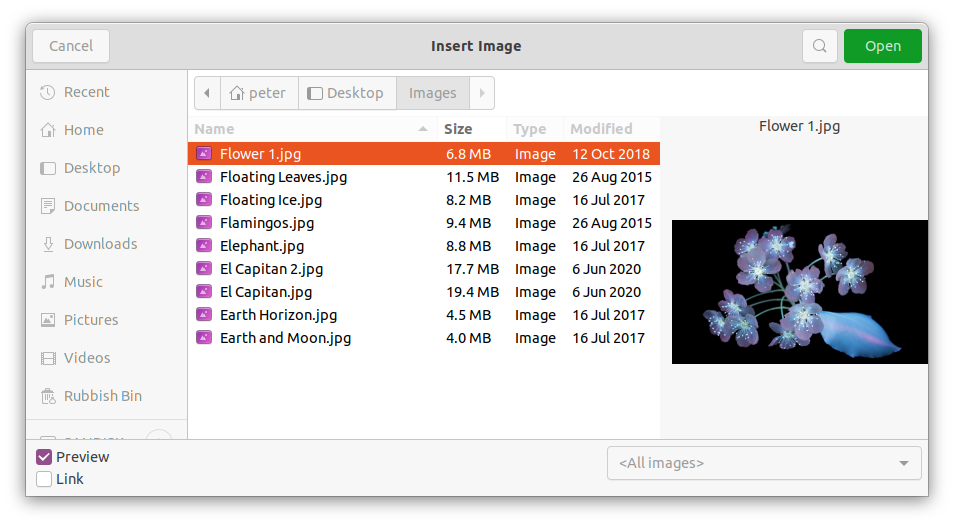
To insert a linked image, select Insert as Link in the Insert Image file browser. The selected image file is then inserted as a link to a file rather than embedding the image file into a presentation. However, it is preferable to embed images so that a presentation can be copied and used on other computers. Sometimes, it makes sense to link an image file rather than embed it and the reasons for linking could be as follows:
When an image file is large, linking rather than embedding dramatically reduces the file size of the presentation.
When the same image file is used in many presentations. For example, when using the same background image for all the presentations created.
When the linked file is only available when the presentation is opened. For example, if the presentation is a slide show of holiday photographs.
Inserting an image from a scanner is normally a simple process if the following points are valid for the computer being used:
Scanner software driver has been installed on the computer.
Scanner is supported by the SANE system and the computer operating system is Linux or other UNIX operating system.
Scanner is TWAIN compatible and the computer is operating Windows or macOS.
Scanner is configured on a computer with LibreOffice software installed.
The following scanning procedure is only an example to demonstrate how to insert an image from a scanner. The actual procedure used depends on computer operating system, the type of scanner being used, and the scanner driver software installed.
1) Prepare the image for the scanner and make sure that the scanner is switched on.
2) If the scanner and scanning software has not been used before, go to Insert > Media > Scan > Select Source on the Menu bar to open a scanner dialog.
3) If the scanner and scanning software is already installed on the computer, then go to Insert > Media > Scan > Request on the Menu bar to open a scanner dialog.
4) If there is more than one scanner connected to a computer, select the scanner from the Select Source or Device Used drop-down list.
5) If available, click Create Preview or Preview to create a preview scan of the image and place it in the preview area.
6) If necessary, crop the scanned image to what is required and make any necessary scanning adjustments.
7) Click Scan and the image is scanned. Impress then places the scanned image in the centre of the selected slide.
8) Format the image to the presentation requirements. See “Formatting images” on page 1 for more information.
The Gallery deck on the Sidebar contains a collection of images that can be used in a presentation. Images can also be added to the Gallery, making it an essential tool for creating presentations quickly. The Gallery is available for all LibreOffice components. For more information on the Gallery, see the Getting Started Guide.
Figure 2: Gallery deck on Sidebar
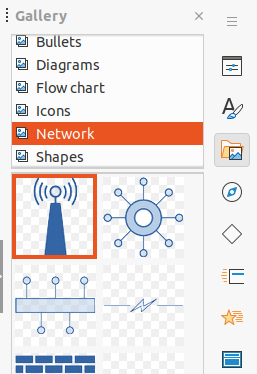
1) Open the Gallery deck in the Sidebar (Figure 2) using one of the following methods:
Go to Insert > Media > Gallery on the Menu bar.
Click on Gallery in the Sidebar.
2) Select a theme from the available themes and the images for that theme are displayed.
3) Scroll through the available images and select the required image.
4) Click and hold on the image and drag it onto the slide. Release the hold and the image is inserted centrally into the slide.
5) Format the image to the presentation requirements. See “Formatting images” on page 1 for more information.
Images in the Gallery are grouped by themes, such as Arrows, Bullets, Diagrams and so on, and these default themes are listed alphabetically in the box at the top of the Gallery deck on the Sidebar (Figure 2). Click on a theme to see its images displayed in the Gallery deck.
The Gallery default themes are read-only. No images or graphics can be added to or deleted from these themes. The default themes are easily identified by right-clicking on a theme name and the only available option in the context menu is Properties.
When custom themes have been created, they are the only themes where images can be added. Custom themes are listed alphabetically, along with the default themes, in the box at the top of the Gallery deck on the Sidebar. Custom themes are easily identified by right-clicking on a theme name and the options available in the context menu are Delete, Rename, and Properties.
1) Open the Gallery deck in the Sidebar using one of the following methods:
Go to Insert > Media > Gallery on the Menu bar.
Click on Gallery in the Sidebar.
2) Click New at the bottom of the Gallery deck and the Properties of New Theme dialog opens (Figure 3).
3) Click on General and type a name for the new theme in the text box.
4) Click OK to save the new theme and close the dialog. The new theme is displayed in the list of themes in the Gallery.
Note
The name of the Properties of New Theme dialog changes to show the name of the newly created custom theme in the Gallery deck.
Figure 3: Properties of New Theme dialog - General page

Figure 4: Properties of New Theme dialog - Files page

1) Right-click on a custom theme name in the theme list on the Gallery deck and select Properties from the context menu to open the Properties of New Theme dialog.
2) Click on Files to open the Files page (Figure 4), then click on Find Files to open a Select Path dialog.
3) Navigate to the folder that contains the images required and select the folder.
4) Click OK to close the Select Path dialog. The files contained in the folder appear in the Properties of New Theme dialog.
5) If necessary, select Preview and any image selected appears in the preview box.
6) Select the files required for the custom theme and click on Add. The added files disappear from the file list and the images appear in the custom theme on the Gallery deck.
7) To add all the files in the list, then click Add All. All the files disappear from the list and the images appear in the custom them on the Gallery deck.
8) Click OK and close the Properties of New Theme dialog.
Only images added to a custom themes can be deleted.
1) Open the Gallery deck and select a custom theme.
2) Right-click on the image being deleted and select Delete from the context menu.
3) Click Yes in the confirmation message to delete the image.
Note
Images in custom themes are linked files and are deleted from the Gallery only. The original image files are not deleted.
All images in the Gallery are linked files. It is recommended that any custom themes are updated on a regular basis to make sure that all the files are still available.
1) Open the Gallery deck and select a new theme that has been created.
2) Right-click on the name of a custom theme that contains at least one image.
3) Select Update from the context menu and the links to all the image files are updated
For more information on moving, resizing, rotating, slanting or skewing images and objects, see Chapter 6, Formatting Graphic Objects.
1) Click on an image to select it and display the selection handles.
2) Move the cursor over the image until it changes shape. The cursor shape depends on the computer operating system, for example a clenched hand.
3) Click and drag the picture to the desired position, then release the cursor when the image is in the desired position.
1) Click on an image to select it and display the selection handles.
2) Position the cursor over one of the selection handles. The cursor changes shape giving a graphical representation of the direction of the resizing.
3) Click and drag the selection handle to resize the image, then release the cursor when the image is at the required size.
Notes
The corner selection handles resize both the width and the height of the graphic object simultaneously. The top and bottom selection handles resize the image height. The left and right selection handles resize the image width.
To retain the original proportions of the graphic, hold down the Shift key, then click on a selection handle and drag the selection handle. Make sure to release the cursor before releasing the Shift key.
Tip
Re-sizing a bitmapped (raster) image affects the image resolution causing some degree of blurring. It is recommended to use a specialized graphics program to correctly scale the picture to the desired size before inserting it into a presentation. LibreOffice recommends Gimp (https://www.gimp.org).
1) Click on an image to select it and display the selection handles.
2) Select rotation mode (Figure 5) using one of the following methods. The color and shape of the selection handles changes depending on the computer operating system and setup.
Click on Rotate on the Drawing toolbar (Figure 6).
Click again on a selection handle.
3) The central selection handle is the normal rotation point for the selected image. If required, click, hold and drag this rotation point to another position (even outside of the image) to change how the selected image is rotated.
4) Click and drag a selection handle to rotate, slant or skew the image as follows. A ghost image appears while dragging the cursor.
Corner selection handles rotate the image.
Left and right selection handles slant the image.
Top and bottom selection handles skew the image.
5) Release the cursor when the required rotation, slanting or skewing is reached.
Note
To restrict the rotation angles to multiples of 15 degrees, click on a selection handle, hold down the Shift key and drag to rotate, slant or skew. Make sure to release the cursor before releasing the Shift key.
Figure 5: Example of rotating, slanting, and skewing images

Legend for Figure 5
1) Rotating mode
2) Rotating image
3) Slanting image
4) Skewing image
Figure 6: Drawing toolbar

Figure 7: Image toolbar

Figure 8: Image Filter toolbar

When an image is selected, the Image toolbar (Figure 7) and the Image Filter toolbar (Figure 8) become available to format an image.
1) Select an image on a slide.
2) Go to View > Toolbars > Image on the Menu bar to open the Image toolbar. The Image toolbar only opens when an image is selected.
3) Click on Filter to open the Image Filter toolbar. The Image Filter toolbar only opens when an image is selected.
4) Select the required filter and it is applied immediately to the image.
5) Alternatively, go to Format > Image > Filter on the Menu bar and select a filter from the submenu. This applies the image filter at the filter default settings.
6) Click outside the image to deselect it and save the presentation.
The effect each image filter has on an image is described below. The best way to judge if a filter works is to try it. See the Draw Guide for more information on image filters and examples of the filter effects.
Invert
Smooth
Sharpen
Remove Noise
Solarization
Aging
Posterize
Pop Art
Charcoal Sketch
Relief
Mosaic
The Image Mode drop-down list on the Image toolbar provides options to change the color or image mode of a selected image. The options for image mode are as follows and an example of using Image Mode is shown in Figure 9.
Default
Grayscale
Black and White
Watermark
Figure 9: Example of image modes
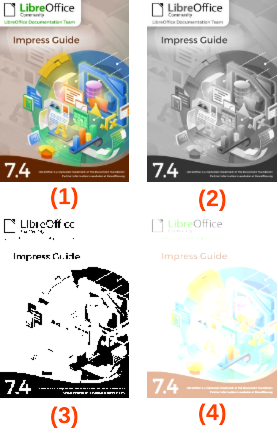
Legend for Figure 9
1) Original
2) Greyscale
3) Black/White
4) Watermark
Figure 10: Example of adjusting color levels

Legend for Figure 10
1) Original
2) 25% Red
3) 25% Green
4) 25% Blue
5) 25% Brightness
6) 50% Contrast
7) Gamma Level 5
Figure 11: Color toolbar

The Color toolbar is used to adjust individual colors within the whole of the image (red, green, blue), as well as the brightness, contrast, and gamma of the image. Increasing the gamma value of an image makes it more suitable to be used as a background or watermark as the image has less interference with a dark text. An example of changing the percentage and levels for color, brightness, contrast, and gamma of an image is shown in Figure 10.
After selecting an image, open the Color toolbar (Figure 11) using one of the following methods to change the values for color adjustment:
• Click on Color in the Image toolbar.
• Go to Format > Image > Color on the Menu bar.
The Color Replacer dialog (Figure 12) only allows a color to be replaced or changed in embedded images for another color or a color set as transparent. The embedded image must be a bitmap (for example BMP, GIF, JPG, or PNG), or a metafile (for example WMF). Up to four colors can be replaced at once. Color Replacer only works on the same color in the entire image. Individual areas in an image cannot be selected for color replacement.
The colors available in the Replace with drop-down lists are all contained in color palettes that are part of the installation of LibreOffice. If any custom colors have been created, then these colors are available in the custom palette. For more information on creating custom colors, see the Draw Guide.
Note
The Color Replacer can only be used on embedded images. If the Color Replacer is used on a linked image, the following error message appears This image is linked to a document. Do you want to unlink the image in order to edit it?.
Figure 12: Color Replacer dialog
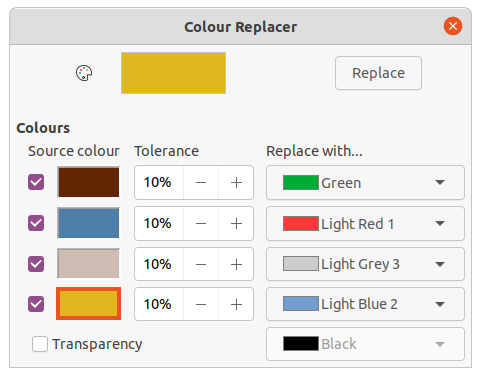
Figure 13: Example of replacing colors
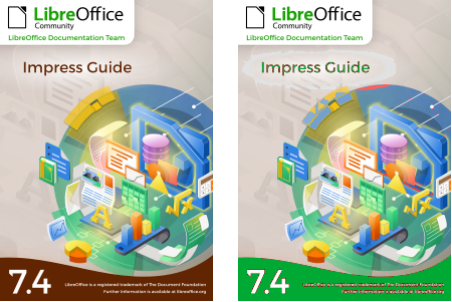
1) Select an embedded image to start using the Color Replacer.
2) Go to Tools > Color Replacer on the Menu bar to open the Color Replacer dialog.
3) Click on Pipette at the top of the Color Replacer dialog to activate the color selection mode.
4) Move the cursor over the color being replaced in the selected image and click on the color. A check box is now marked and the selected color appears in Source color.
5) If necessary, select another three colors in the selected image. A maximum of four colors can be selected.
6) Enter the amount of tolerance required for replacing the color in the Tolerance box. The default selection is 10% tolerance.
7) Select a color from the color palettes available in the Replace with drop-down list for each color selected. Transparent is the default selection.
8) After selecting up to four colors for replacement, click Replace to replace the colors in the selected image. An example of replacing colors is shown in Figure 13.
9) There is no preview of the effect. If the result is not what is required, select Edit > Undo in the Menu bar and repeat the color replacement.
Notes
If the Replace button does not become active when replacing colors, then the file format of the image is not compatible with LibreOffice Impress.
Using Color Replacer replaces all occurrences of the Source color in the selected image.
The default selection of Transparent in Replace with removes the selected color from the image and creates transparent areas in the image.
1) Select an embedded image to start using the Color Replacer.
2) Go to Tools > Color Replacer on the Menu bar to open the Color Replacer dialog.
3) Select Transparency in the Color Replacer dialog.
4) Select a color from the available color palettes in the drop-down list next to Transparency.
5) Click Replace to replace the transparent areas with the selected color.
6) There is no preview of the effect. If the result is not what is required, select Edit > Undo in the Menu bar and repeat the transparency replacement.
The Tolerance parameter is used to set how much of the source color in an embedded image is replaced by another color.
Replacing colors that are similar to the color being replaced, enter a low value for the tolerance parameter.
Replacing a wider range of colors, enter a higher value for the tolerance parameter.
Specifies the transparency in an image. A percentage value of 0% is a fully opaque image and a percentage value of 100% is a fully transparent image. As with the gamma value of an image, increasing the transparency makes the image blend more smoothly into the background making any overlay text easier to read.
Figure 14: Example of changing image transparency
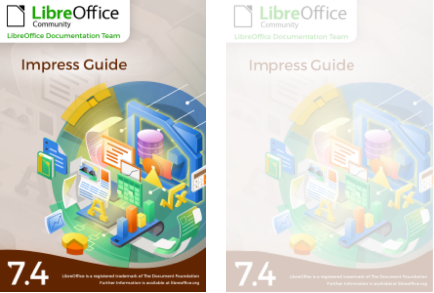
Figure 15: Area dialog - Shadow page
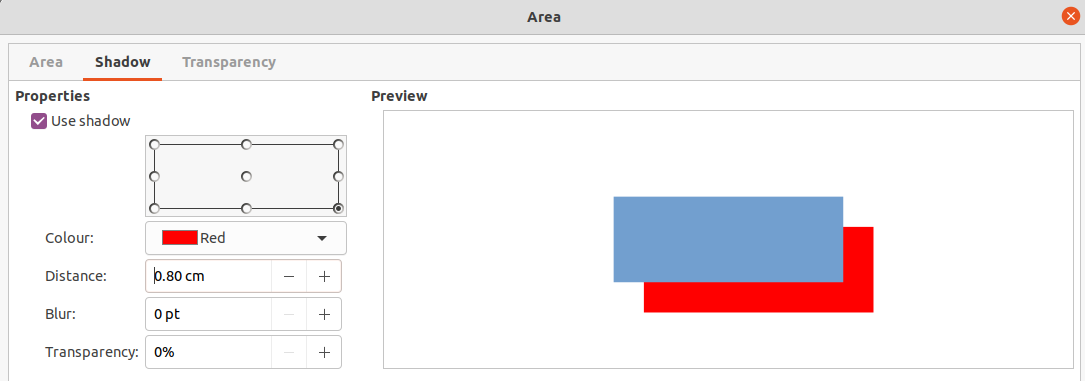
Click on Transparency on the Image toolbar and change the percentage value in the text box to adjust the image transparency. An example of adjusting the transparency percentage is shown in Figure 14.
Select an image, then click on Shadow on the Image toolbar to apply a shadow to the image. The shadow applied uses the settings from the Shadow page of the Area dialog (Figure 15). If a shadow is already applied to the image, clicking on Shadow removes the shadow from the image.
The preview box in the dialog shows how the shadow looks when the settings are adjusted and applied as follows:
1) Go to Format > Text Box and Shape > Area on the Menu bar to open the Area dialog.
2) Click on Shadow to open the Shadow page.
3) Select the option Use shadow in Properties.
4) Select the shadow position from one of nine positions for casting the shadow from the image.
5) Select a shadow color from the available color palettes in the Color drop-down list.
6) Enter a distance for the shadow to be offset from the image in the Distance box.
7) Enter a value in the Blur box to create a softer look for the shadow. The higher the setting, the softer the shadow appears. Value of 0 (minimum), the shadow is sharp. The value of 150 (maximum), the shadow is at its softest.
8) Enter a percentage in the Transparency box. The value of 0% (minimum), the shadow is opaque. The value of 100% (maximum), the shadow is transparent.
9) Click on OK to close the Area dialog and save the changes to the shadow setting.
Note
After changing the shadow settings in the Area dialog, these shadow settings are applied to an image each time Shadow on the Image toolbar is used to apply a shadow.
Figure 16: Image cropping marks

In Impress, images can be cropped using a mouse or a dialog. Mouse cropping is easier, but dialog cropping provides more precise control.
1) Select an image and use one of the following methods to put the image into cropping mode and crop marks appear around the image (Figure 16):
Click Crop Image on the Image toolbar.
Go to Format > Image > Crop on the Menu bar.
Right click on the image and select Crop from the context menu.
2) Place the cursor over any of the crop marks and the cursor changes shape. Click, hold and drag the crop mark to crop the image.
Corner crop marks change width and height of an image.
Left and right crop marks change the width of an image.
Top and bottom crop marks change the height of an image.
3) Click outside the image to deactivate cropping mode.
Note
Press and hold the Shift key, then click, hold and drag a crop mark to proportionally reduce width and height of the image at the same time. Release the cursor before releasing the Shift key.
1) Select an image and go to Format > Image > Crop Dialog Box on the Menu bar to open the Crop dialog (Figure 17).
Figure 17: Crop dialog
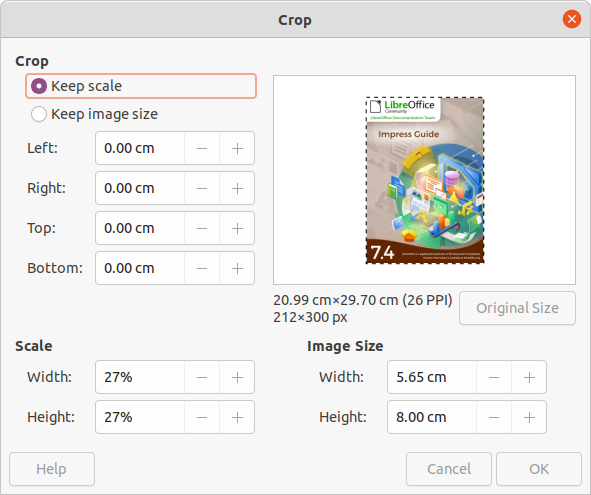
Figure 18: Example of Keep scale cropping

Figure 19: Example of Keep image style cropping

2) Crop the image using the options given in the Crop dialog. A preview of the selected image and cropping results appear in the dialog.
3) To return to the original size of the image and cancel the cropping, click on Original Size.
4) Click OK to save the changes and close the dialog.
The following options are available in the Crop dialog:
Crop
Keep scale
Maintains the original scale of the image when cropped. The size of the image changes to the cropped size (Figure 18).
Keep image size
Maintains the original size of the image when cropped. The scale of the image changes (Figure 19). To reduce the scale of the graphic, select this option and enter negative values in the cropping boxes. To increase the scale of the graphic, enter positive values in the cropping boxes.
Left
If Keep scale is selected, enter a positive amount to trim the left edge of the image, or a negative amount to add white space to the left of the image. If Keep image size is selected, enter a positive amount to increase the horizontal scale of the image, or a negative amount to decrease the horizontal scale of the image.
Right
If Keep scale is selected, enter a positive amount to trim the right edge of the image, or a negative amount to add white space to the right of the image. If Keep image size is selected, enter a positive amount to increase the horizontal scale of the image, or a negative amount to decrease the horizontal scale of the image.
Top
If Keep scale is selected, enter a positive amount to trim the top of the image, or a negative amount to add white space above the image. If Keep image size is selected, enter a positive amount to increase the vertical scale of the image, or a negative amount to decrease the vertical scale of the image.
Bottom
If Keep scale is selected, enter a positive amount to trim the bottom of the image, or a negative amount to add white space below the image. If Keep image size is selected, enter a positive amount to increase the vertical scale of the image, or a negative amount to decrease the vertical scale of the image.
Scale
Width
Enter the width for the selected image as a percentage.
Height
Enter the height of the selected image as a percentage.
Image Size
Width
Enter a width for the selected image.
Height
Enter a height for the selected image.
Original Size
Click on an image to display the selection handles and press the Delete or Backspace key.
Figure 20: Image Map dialog

An image map defines areas of the image (called hotspots) associated with a URL (a web address or a file on the computer). Hotspots are the graphic equivalent of text hyperlinks. In Impress, clicking on a hotspot opens the linked page in the appropriate program (for example, default browser for HTML pages; LibreOffice Writer for ODT files; PDF viewer for PDF files).
Hotspots can be created in various shapes, such as rectangles, ellipses, and polygons, and several hotspots can be included in the same image. When clicking on a hotspot, the URL opens in a browser window or frame that has been specified. Also, text can be specified to appear when the cursor hovers over a hotspot.
Use the ImageMap dialog (Figure 20) to create or edit a hotspot:
1) Select an image on a slide and go to Tools > ImageMap on the Menu bar and the ImageMap dialog opens. The main part of the dialog shows the selected image where hotspots will be defined.
2) Use the tools at the top of the dialog and the fields to define hotspots and their links.
3) Click on Apply to apply the settings.
4) When finished, click on Save to save the image map to a file and open a file browser.
5) Navigate to the folder where the image map is going to be saved and enter a name for the image map.
6) Click on Save and the file browser closes.
7) Click on Close to close the ImageMap dialog.
The tools available in the ImageMap dialog are as follows:
Apply
Open
Save
Close
Select
Rectangle, Ellipse, Polygon and FreeForm Polygon
Edit Points, Move Points, Insert Points, Delete Points
Undo
Redo
Active
Macro
Properties
Address
Text
Frame
_blank
Opens in a new browser window.
_self
Default selection and opens in the current window.
_top
File opens in the topmost frame in the hierarchy.
_parent
File opens in the parent frame of the current frame. If there is no parent frame, the current frame is used.
Tip
The value _self for the target frame works on the vast majority of occasions. It is not recommended to use the other values, if available, unless absolutely necessary.